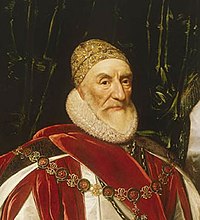Charles Howard, 1st Earl of Nottingham

Charles Howard, 1st Earl of Nottingham (1536-December 14, 1624) was an English statesman and admiral.
He was son of William Howard, 1st Baron Howard of Effingham (c. 1510 - 1573) and Margaret Gamage (d. May 18, 1531), daughter of Sir Thomas Gamage. He was a grandson of Thomas Howard, 2nd Duke of Norfolk.
In June 1563 he married Katherine Carey, the oldest daughter of Henry Carey, 1st Baron Hunsdon, later Lord Chamberlain. It is a curiosity of history that the patrons of the two most important acting companies at the height of Elizabethan Drama (1594-1603), the Admiral's Men and the Lord Chamberlain's Men, were son-in-law and father-in-law.
He succeeded his father as 2nd Baron Howard of Effingham in 1573 and was created Earl of Nottingham on October 22, 1596.
Howard served at sea under his father's command as a youth. He was the cousin of Elizabeth I and held several prominent posts during her reign. He served as Ambassador to France in 1559. He represented Surrey in Parliament in 1562. He served as General of the Horse in 1569 and suppressed a Catholic rebellion in northern England. He commanded a squadron of ships escorting the Queen of Spain on a state visit in 1570. He was named as Commissioner at the trial of Queen Mary in 1586 and subsequently recommended her execution.
Howard was knighted in 1572 and became Lord Howard of Effingham following his father's death in 1573.
Effingham was named Lord High Admiral in 1585. In 1587, he was named as commander-in-chief of the English fleet against the Spanish Armada although he did not directly take charge of the fighting. Effingham ordered an indirect strategy of harassing the Spanish fleet rather than attacking them directly. While controversial, the strategy succeeded. In 1596, when another Spanish invasion was feared, Effingham was again appointed to defend England. Effingham and the Earl of Essex jointly led an attack against the Spanish base at Cadiz on June 20.
Effingham was created Earl of Nottingham in 1596 and was appointed Lord Lieutenant General of England. When Essex rebelled in 1601, Effingham defeated him in the field and served as commissioner at his subsequent trial.
Effingham was at Elizabeth's deathbed in 1603 and later enjoyed the confidence of her successor, James I. Under James, he served on the commission of union between England and Scotland and served as commissioner at the Gunpowder Plot trial in 1605.
Effingham died in 1624 at the age of 88. There is now a mixed comprehensive school named after him.
None of his three sons left heirs, and shortly after the last died the Nottingham earldom was recreated for a close relative of the Earl of Winchilsea; the Howard of Effingham barony passed to descendants of his brother, the Earl of Effingham being the modern heir.
Children
He was married first to Katherine Carey, daughter of Henry Carey, 1st Baron Hunsdon and Ann Morgan. They had five children:
- Lady Frances Howard (buried July 11, 1628). She was married first to Henry FitzGerald, 12th Earl of Kildare. She was secondly married to Henry Brooke, 11th Baron Cobham.
- William Howard, Lord Howard (December 27, 1577 - November 28, 1615). He was married on February 7, 1596/1597 to Anne St. John.
- Charles Howard, 2nd Earl of Nottingham (September 17, 1579 - October 3, 1642). He was married first on May 19, 1597 to Charity White (d. December 18, 1618), daughter to Robert White. Secondly on April 22, 1620 to Mary Cokayne , daughter of Sir William Cokayne who served as Lord Mayor of London in 1619 and Mary Morris.
- Lady Margaret Howard. She was married to Sir Richard Levenson.
- Lady Elizabeth Howard (buried March 31, 1646). Maid of honour to Elizabeth I of England. She was married first to Sir Robert Southwell. She was secondly married to John Stewart, 1st Earl of Carrick.
He was married secondly to Margaret Stuart, daughter of James Stuart, 3rd Earl of Moray and Elizabeth Stuart, 2nd Countess of Moray. They had two children:
- Charles Howard, 3rd Earl of Nottingham (1610–1681)
- Lady Anne Howard (born c. 1612). She was married on December 29, 1627 to Alexander Stewart, Baron Garlies, son of Alexander Stewart, 1st Earl of Galloway and Grizel Gordon.
Reference
- Robert W. Kenny, Elizabeth's Admiral: The Political Career of Charles Howard, Earl of Nottingham 1536-1624, Baltimore, The Johns Hopkins Press, 1970.
